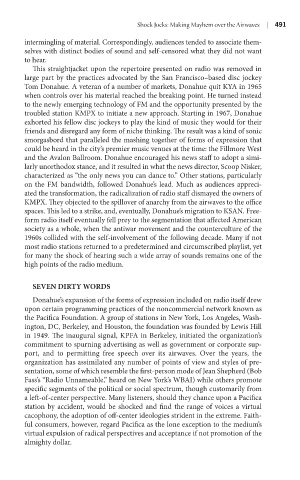Page 512 - Battleground The Media Volume 1 and 2
P. 512
Shock Jocks: Mak ng Mayhem over the A rwaves | 1
intermingling of material. Correspondingly, audiences tended to associate them-
selves with distinct bodies of sound and self-censored what they did not want
to hear.
This straightjacket upon the repertoire presented on radio was removed in
large part by the practices advocated by the San Francisco–based disc jockey
Tom Donahue. A veteran of a number of markets, Donahue quit KYA in 1965
when controls over his material reached the breaking point. He turned instead
to the newly emerging technology of FM and the opportunity presented by the
troubled station KMPX to initiate a new approach. Starting in 1967, Donahue
exhorted his fellow disc jockeys to play the kind of music they would for their
friends and disregard any form of niche thinking. The result was a kind of sonic
smorgasbord that paralleled the mashing together of forms of expression that
could be heard in the city’s premier music venues at the time: the Fillmore West
and the Avalon Ballroom. Donahue encouraged his news staff to adopt a simi-
larly unorthodox stance, and it resulted in what the news director, Scoop Nisker,
characterized as “the only news you can dance to.” Other stations, particularly
on the FM bandwidth, followed Donahue’s lead. Much as audiences appreci-
ated the transformation, the radicalization of radio staff dismayed the owners of
KMPX. They objected to the spillover of anarchy from the airwaves to the office
spaces. This led to a strike, and, eventually, Donahue’s migration to KSAN. Free-
form radio itself eventually fell prey to the segmentation that affected American
society as a whole, when the antiwar movement and the counterculture of the
1960s collided with the self-involvement of the following decade. Many if not
most radio stations returned to a predetermined and circumscribed playlist, yet
for many the shock of hearing such a wide array of sounds remains one of the
high points of the radio medium.
sEvEn DirTy worDs
Donahue’s expansion of the forms of expression included on radio itself drew
upon certain programming practices of the noncommercial network known as
the Pacifica Foundation. A group of stations in New York, Los Angeles, Wash-
ington, DC, Berkeley, and Houston, the foundation was founded by Lewis Hill
in 1949. The inaugural signal, KPFA in Berkeley, initiated the organization’s
commitment to spurning advertising as well as government or corporate sup-
port, and to permitting free speech over its airwaves. Over the years, the
organization has assimilated any number of points of view and styles of pre-
sentation, some of which resemble the first-person mode of Jean Shepherd (Bob
Fass’s “Radio Unnameable,” heard on New York’s WBAI) while others promote
specific segments of the political or social spectrum, though customarily from
a left-of-center perspective. Many listeners, should they chance upon a Pacifica
station by accident, would be shocked and find the range of voices a virtual
cacophony, the adoption of off-center ideologies strident in the extreme. Faith-
ful consumers, however, regard Pacifica as the lone exception to the medium’s
virtual expulsion of radical perspectives and acceptance if not promotion of the
almighty dollar.

